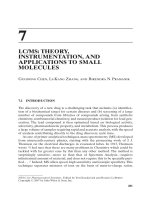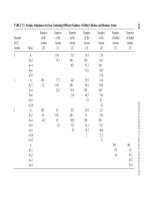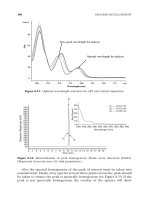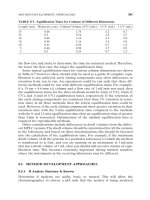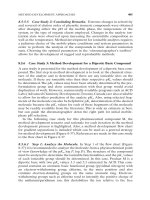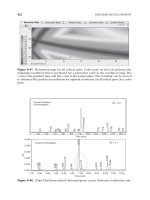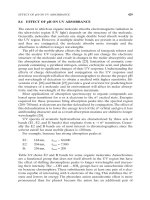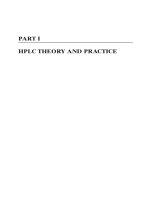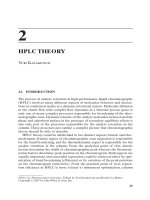Tài liệu HPLC for Pharmaceutical Scientists 2007 (Part 4C) pdf
Bạn đang xem bản rút gọn của tài liệu. Xem và tải ngay bản đầy đủ của tài liệu tại đây (576.58 KB, 37 trang )
ION-INTERACTION CHROMATOGRAPHY 203
Figure 4-43. Adsorption isotherms of alkylsulfates on Hypersil-ODS from
methanol/water (20/80) with 0.02 M phosphate buffer at pH 6.0. (Reprinted from ref-
erence 119, with permission.)
Figure 4-44. Capacity factor of tyrosinamide versus concentrations of dodec
yl sulfate
(upper curve), decyl sulfate (middle curve), and octyl sulfate (lower curve). (Reprinted
from reference 119, with permission.)
similarly charged analytes as the ion pairing reagent will elute faster. This
indeed has been observed experimentally (Figure 4-46). Figure 4-45 shows
the similar retention dependencies of adrenaline retention for different
amphiphilic ions adsorbed on the surface of the reversed-phase material, indi-
cating that at the same surface concentration of any amphiphilic ion adsorbed,
the retention of basic analyte is the same; thus the retention is dependent on
the surface charge density of adsorbed ions. Comparison of Figures 4-46 and
4-45 indicates that the retention of a charged analyte in ion-pairing mode is
dependent on the adsorption of ion-pairing ions on the surface of the sta-
tionary phase and not on its concentration in the mobile phase.
Same were also observed by Knox in a salt-controlled methanol-aqueous
eluent for the analysis of normetadrenaline as a function of octyl, decyl, and
lauryl sulfates [119].
In the contrast to the irreversible adsorption of amphiphilic ions on the
reversed-phase surface, the liophilic ions shows relatively weak interactions
with the alkyl chains of the bonded phase. Liophilic means oil-loving. These
liophilic ions are usually small inorganic ions and they possess an important
ability for dispersive type interactions. They are (a) characterized by signifi-
cant delocalization of the charge, (b) primarily symmetrical, (c) usually spheri-
cal in shape, and (d) absence in surfactant properties.
The presence of these ions in aqueous solution was found to disrupt the
water structure [146]; in other words, they introduce chaos into structured ionic
solution that hence are given the name “chaotropic” ions [147]. The effect of
chaotropic ions on the disruption of the solvation shell was mainly studied in
204 REVERSED-PHASE HPLC
Figure 4-45. Dependence of the retention factor of adrenaline on the concentration of
amphiphilic ions on the stationary phase surface. Retention factor shown in logarith-
mic scale. (Reprinted from reference 136, with permission.)
the field of biochemistry, where it was shown that they can impact the con-
formational and the solvation behavior of proteins and peptides [146, 147].
Inorganic ions were arranged according to their ability to disrupt a water sol-
vation shell in the so-called Hofmeiser series [148]. An increase of chaotropi-
city [149] has a relatively vague phenomenological description, which is
essentially related to the increase in hydrophobicity as a result of charge delo-
calization and significant polarizability. In the sequence
H
2
PO
4
−
< CF
3
COO
−
< BF
4
−
< ClO
4
−
< PF
6
−
a greater possibility for charge delocalization and higher overall electron
density is seen from left to right, with a simultaneous increase in the symme-
try. This leads to an increasing ability of these ions to participate in dispersive
interactions.
ION-INTERACTION CHROMATOGRAPHY 205
Figure 4-46. Logarithm of the retention of dopamine and 1-benzenesulfonic acid on
reversed-phase column as a function of the mobile-phase concentration of ion-pairing
additives (pH 2.1). Column: Hypersil-ODS, T = 25°C; constant ionic strength was main-
tained by addition of NaH
2
PO
4
; open circles, butylsulfate; triangles, cyclohexylsulfamic
acid; ×, d-camphor-10-sulfonic acid; half-closed circles, 1-hexanesulfonate; black circles,
octansulfonate. (Reprinted from reference 145, with permission.)
4.10.4 Chaotropic Effect
Study of the effect of liophilic ions on the retention of ionic analytes in
reversed-phase HPLC has led to the development of yet another possible
theory of their influence on the chromatographic retention of basic com-
pounds [150–152]. Ionic analytes in water/organic mixtures are solvated. The
solvation shell suppresses the analyte’s ability for hydrophobic interactions
with the stationary phase, thus effectively decreasing the analyte’s retention.
Controlled disruption of the solvation shell allows for control of the analyte
retention. Presence of the counterions in the close proximity to the ionic sol-
vated analyte leads to the disruption of the analyte solvation shell. This effect
is known as chaotropic control for the retention of ionic compounds in
reversed-phase chromatography. Counteranions that have a less localized
charge, high polarizability, and lower degree of hydration show a significant
effect on the retention of protonated basic analytes and are known as
chaotropic ions. Chaotropic ions change the structure of water in the direction
of greater disorder. Therefore, the solvation shell of the basic analytes may be
disrupted due to ion interaction with the chaotropic anions.
With the increase of the counteranion concentration, the solvation of the
protonated basic analyte decreases. The primary sheath of water molecules
around the basic analytes is disrupted, and this decreases the solvation of the
basic analyte. The decrease in the analyte solvation increases the analyte
hydrophobicity and leads to increased interaction with the hydrophobic sta-
tionary phase and increased retention for the basic analytes.
The chaotropic effect is dependent on the concentration of the free coun-
teranion and not the concentration of the protons in solution at pH < basic
analyte pK
a
. This suggests that change in retention of the protonated basic
analyte may be observed with the increase in concentration of the coun-
teranion by the addition of a salt at a constant pH as shown in Figure 4-47 for
a pharmaceutical compound containing an aromatic amine with a pK
a
of 5.
In the example in Figure 4-47, the retention of pharmaceutical analyte X
was first altered by decrease of mobile-phase pH (Figure 4-47A), and in the
second case (Figure 4-47B) the pH was maintained constant and the concen-
tration of counteranion was increased via addition of its sodium salt. The
resulting effect on the retention of basic analyte is strikingly similar if both
dependencies are plotted against the concentration of free counteranions of
ClO
4
−
, as shown in Figure 4-48.
Disruption of the basic analyte solvation shell should be possible with prac-
tically any counteranion employed, and the degree of this disruption will be
dependent on the “chaotropic nature” of the anion. Chaotropic activity of
counteranions has been established according to their ability to destabilize or
bring disorder (bring chaos) to the structure of water [148, 149].
Even a very low counteranion concentration in the mobile phase will cause
significant initial disruption of the solvation shell, thus leading to the signifi-
cant increase of the analyte retention, while in the high concentration region
206 REVERSED-PHASE HPLC
a type of a saturation effect is observed (Figure 4-49). Logically, at high coun-
teranion concentration when all solvation shells are fully disrupted, any
further increase of the counteranion concentration should not cause any addi-
tional retention increase.
As was shown above, the chaotropic effect is related to the influence of the
counteranion of the acidic modifier on the analyte solvation and is indepen-
dent on the mobile-phase pH, provided that complete protonation of the basic
analyte is achieved. Analyte interaction with a counteranion causes a disrup-
tion of the analyte solvation shell, thus affecting its hydrophobicity. Increase
of the analyte hydrophobicity results in a corresponding increase of retention.
This process shows a “saturation” limit, when counteranion concentration is
high enough to effectively disrupt the solvation of all analyte molecules. A
further increase of counteranion concentration does not produce any notice-
able effect on the analyte retention.
ION-INTERACTION CHROMATOGRAPHY 207
Figure 4-47. Variation of the retention of basic analyte (pK
a
> 5) with mobile-phase
pH (A) and counteranion concentration (B). (Reprinted from reference 185, with
permission.)
4.10.4.1 Chaotropic Model. If the counteranion concentration is low, some
analyte molecules have a disrupted solvation shell, and some do not due to
the limited amount of counteranions present at any instant within the mobile
phase. If we assume an existence of the equilibrium between solvated and
desolvated analyte molecules and counteranions, this mechanism could be
described mathematically [151].
208 REVERSED-PHASE HPLC
Figure 4-48. Retention of basic analyte (pK
a
> 5) as a function of ClO
4
−
counteranion
concentration with variable pH (circles), fixed pH (triangles), and variable pH with
phosphate buffer (squares). (Reprinted from reference 185, with permission.)
Figure 4-49. Influence of different counteranions on the retention of 3,4-
dimethylpyridine. (Reprinted from reference 185, with permission.)
The assumptions for this model are:
1. Analyte concentration in the system is low enough that analyte–analyte
interactions could be considered nonexistent.
2. The chromatographic system is in thermodynamic equilibrium.
The analyte solvation–desolvation equilibrium inside the column could be
written in the following form:
(4-30)
where B
+
s
is a solvated basic analyte, A
−
is a counteranion, and B
+
· · · A
−
is the
desolvated ion-associated complex.The total amount of analyte injected is [B],
analyte in its solvated form is [B
+
s
], and analyte in its desolvated form is
denoted as [B
+
· · · A
−
], indicating its interaction with counteranions.
The equilibrium constant of reaction (4-30) is
(4-31)
Total analyte amount is equal to the sum of the solvated and desolvated forms
of analyte
(4-32)
The fraction of solvated analyte could be expressed as
(4-33)
The fraction of the desolvated analyte in the mobile phase could be expressed
as
(4-34)
Substituting expressions (4-33) and (4-34) into expression (4-31), we can write
an expression for the equilibrium constant:
(4-35)
Solving equation (4-35) for θ (solvated fraction), we get
K
A
=
−
⋅
[]
−
1 θ
θ
1−=
[]
[]
+−
θ
BA
B
...
θ=
[]
[]
+
B
B
s
BB B A
s
[]
=
[]
+
[]
++−
...
K
BA
BA
s
=
[]
[][]
+−
+−
...
BA B A
s
+− + −
+⇔...
ION-INTERACTION CHROMATOGRAPHY 209
(4-36)
Expression (4-36) shows that the solvated fraction of the analyte is dependent
on the counteranion concentration and desolvation equilibrium parameter.
Completely solvated analyte has a low retention factor (even if it is equal
to 0), which we denote as k
s
, while the corresponding retention factor for
desolvated form is denoted as k
us
.
Assuming that solvation–desolvation equilibrium is fast, we can express the
overall retention factor of injected analyte as a sum of the retention factor of
solvated form multiplied by the solvated fraction (θ) and the retention factor
of the desolvated form multiplied by the desolvated fraction (1 −θ), or
(4-37)
Substituting θ in equation (4-37) from (4-36), we get
(4-38)
and the final form can be rewritten as
(4-39)
This equation has three parameters: k
s
is a “limiting” retention factor for sol-
vated analyte, k
us
is a “limiting” retention factor for desolvated analyte, and K
is a desolvation parameter [151]. The description of the experimental results
with function (4-39) is shown in Figure 4-50. Expression (4-39) in principle
allows for the calculation of the solvation equilibrium constant from experi-
mental chromatographic data.
4.10.4.2 Effect of Different Counteranions. The chaotropic theory was
shown to be applicable in many cases where small inorganic ions were used
for the alteration of the retention of basic pharmaceutical compounds
[153–157]. Equation (4-39) essentially attributes the upper retention limit for
completely desolvated analyte to the hydrophobic properties of the analyte
alone. In other words, there may be a significantly different concentration
needed when different counterions are employed in the eluent for complete
desolvation of the analyte.Therefore, the resulting analyte hydrophobicity and
thus retention characteristics of analyte in completely desolvated form should
be essentially independent on the type of counteranion employed. Experi-
mental results, on the other hand, show that the use of different counterions
k
kk
KA
k
sus
us
=
−
⋅
[]
+
+
−
1
kk
KA
k
KA
k
susus
=
[]
+
−
[]
+
+
−−
1
1
1
1
kk k
sus
=⋅+ ⋅−
()
θθ1
θ=
[]
+
−
1
1KA
210 REVERSED-PHASE HPLC
leads to the different retention limits of completely desolvated analyte. Figure
4-51 clearly illustrates this effect. This discrepancy could be explained by the
presence of two simultaneous processes: the desolvation and ion association
(ion pairing). The effect of the counterion concentration on the analyte reten-
tion in both processes (desolvation and ion pairing) have Langmurian shape
[156], and overall retention is a superposition of both effects.
ION-INTERACTION CHROMATOGRAPHY 211
Figure 4-50. Experimental dependence of the retention of basic analyte on the coun-
teranion concentration (points), along with corresponding theoretical curve for
this effect calculated using equation (4-39). (Reprinted from reference 185, with
permission.)
Figure 4-51. Retention factor variations for acebutolol analyzed with different
chaotropic agents. (Reprinted from reference 156, with permission.)
4.10.4.3 Retention of the Counteranions. Three distinct processes could be
envisioned in the effect of chaotropic ions on the retention of basic analytes:
1. Classic ion pairing involves the formation of essentially neutral ion pairs
and their retention according to the reversed-phase mechanism.
2. In the chaotropic model, counteranions disrupt the analyte solvation
shell, thus increasing its apparent hydrophobicity and retention.
3. Liophilic counteranions are adsorbed on the surface of the stationary
phase, thus introducing an electrostatic component into the general
hydrophobic analyte retention mechanism.
In their recent papers, Guiochon and co-workers are essentially advocating
for the domination of the first process [158–160].They are explaining the coun-
teranion effect on the basis of the formation of a neutral ionic complex, fol-
lowed by its adsorption on the hydrophobic stationary phase. Similarity in
adsorption behavior of anionic and cationic species is interpreted as a confir-
mation of their adsorption in the form of neutral complexes.
The retention of ionic components on reversed-phase columns is essentially
regarded as ion-pair chromatography, which has been extensively developed
by Horvath [161] and Sokolovski [162, 163] in the form of stochiometric
adsorption of ionic species and by Stählberg in the form of adsorption of ions
and formation of an electrical double layer [164].
The adsorption of amphiphilic ions was experimentally confirmed about 30
years ago, while the actual interaction of the small liophilic ions with
hydrophobic stationary phase in reversed-phase conditions was found only
recently [165].
Most probably all three mechanisms exist while one of them is dominat-
ing, depending upon the eluent type, composition, and adsorbent surface
properties.
For acetonitrile/water systems it was found that acetonitrile forms thick
adsorbed layer on the surface of hydrophobic bonded phase, while methanol
adsorption from water formed a classical monomolecular adsorbed layer
[166]. The thick adsorbed layer of acetonitrile provides a suitable media for
the adsorption of liophilic ions on the stationary phase adding an electrosta-
tic component to the retention mechanism, while monomolecular adsorption
of methanol should not significantly affect adsorption of ions.
The study of the retention of chaotropic anions (BF
4
−
, perchlorate, and
PF
6
−
) was performed using acetonitrile/water eluents on alkyl- and phenyl-
type phases with LC–MS detection (electrospray, negative ion mode) [165]. At
all mobile-phase conditions with acetonitrile/water PF
6
−
ion exhibits the great-
est retention, and this is the most liophilic ion in the Hoffmeister series. This
ion has the highest degree of charge delocalization and highest polarizability,
which facilitates its possible dispersive (or van der Waals) interactions. These
properties allow this ion to interact with acetonitrile. Other anions
have similar properties, but their ability for dispersive interactions is lower
212 REVERSED-PHASE HPLC
then PF
6
−
. At acetonitrile concentrations up to 20 v/v% acetonitrile, all ions
exhibit a maximum retention.
General dependence of the analyte retention on the eluent composition in
reversed-phase HPLC shows an exponential decay with the increase of the
organic modifier concentration.This is usually described in the following form:
(4-40)
where k is a retention factor, x is the eluent composition, and a and b are con-
stants. This relationship has a thermodynamic background because in the par-
titioning retention model the retention factor is proportional to the
distribution equilibrium constant, which in turn is an exponent of the exces-
sive free Gibbs energy of the analyte in the chromatographic system. Exces-
sive free Gibbs energy is the difference of the analyte potential in the
stationary phase and its potential in the eluent. This is only true if retention is
a result of a single process on the adsorbed surface (e.g., partitioning, or
adsorption). If, on the other hand, the retention mechanism is complex, reten-
tion dependencies will not adhere to equation (4-40).
The thick acetonitrile layer adsorbed on the bonded phase surface acts
as a pseudo-stationary phase, thus making retention in acetonitrile/water
systems a superposition of two processes: partitioning into the acetonitrile
layer and adsorption on the surface of the bonded phase. Based on the model
described in reference 166, analyte retention could be represented in the
following form:
(4-41)
where V
R
(c
el
) is the retention volume of analyte ions as a function of the eluent
composition, V
0
is the void volume, K
p
(c
el
) is the equilibrium constant for the
distribution of the analyte ions between the eluent and adsorbed layer, V
ads
, S
is the adsorbent surface area, and K
H
is the adsorption equilibrium constant
for analyte ions adsorption from neat acetonitrile on the corresponding sta-
tionary phase.
Semiempirical expression was derived for the description of the retention
of chaotropic counteranions in reversed-phase conditions [165]. Overall
expression for the description of the retention dependencies of analyte ions
versus eluent composition will have only four unknowns and allow numerical
approximation of experimental retention data (shown as a function of the
mole fraction of organic eluent component).
(4-42)
Essentially equation (4-42) describes the retention volume of the analyte
as a sum of the mobile-phase volume (V
0
− V
ads
, assuming that adsorbed
Vx V V x A
GxG
RT
VxSK
R H
()
=−
()
+⋅
−
⋅
()
+
()
0 ads
MeCN el
ads.
.
.
exp
∆∆
Vc V Kc V SKKc
Rp Hpel el ads el
()
=+
()
−
()
+
()
0
1
ln kaxb
()
=+
ION-INTERACTION CHROMATOGRAPHY 213
acetonitrile layer is stagnant) and an energetic term that describes analyte (in
this case, chaotropic anion) partitioning into the adsorbed layer and its adsorp-
tion on the stationary phase surface. Volume of the adsorbed layer on top of
the bonded phase is also a function of the acetonitrile concentration in the
mobile phase (Figure 4-52).
Coefficient ∆G
el
in equation (4-42) has a meaning of energetic span of par-
titioning constant in the whole concentration region, and it reflects (a) the
excessive interactions of studied ions with water and acetonitrile and (b) struc-
tural organization of molecules.
The suggested phenomenological model describes the retention of PF
6
−
ions
on different reversed-phase columns very well. Average deviation of calcu-
lated values from experimentally measured values is on the level of 1%, which
confirms that indeed a superposition of several processes govern the retention
of liophilic ions in acetonitrile/water systems. Experimental values along with
the theoretical curves are shown in Figure 4-53.
The multilayered character of acetonitrile adsorption creates a pseudo-
stationary phase of significant volume on the surface, which acts as a suitable
phase for the ion accumulation. In the low organic concentration region (from
0 to 20 v/v% of acetonitrile), studied ions show significant deviation from the
ideal retention behavior (decrease in ion retention with increase in acetoni-
trile composition) due to the formation of the acetonitrile layer, and signifi-
cant adsorption of the chaotropic anions was observed. This creates an
electrostatic potential on the surface in which there is an adsorbed acetoni-
trile layer, which provides an additional retentive force for the enhancement
of the retention of protonated basic analytes. When the dielectric constant is
lower than 42 [167], this favors the probability of ion pair formation in this
organic enriched layer on top of the bonded phase.
However, at high concentration of organic (>25 v/v%) in the mobile phase
the retention of counteranions start to decrease, and this is attributed to the
214 REVERSED-PHASE HPLC
Figure 4-52. Acetonitrile excess adsorption isotherm from water on Zorbax Eclipse
XDB-C8 adsorbent (left); normalized filling of adsorbed layer (right). (Reprinted from
reference 165, with permission.)
normal effect of the increase of the organic composition in the mobile phase
on the retention of the analyte, which shows an exponential decay. The
schematic of the retention mechanism of basic analytes in the presence of lio-
philic ions in acetonitrile/water mobile phase is depicted in Figure 4-54. Ace-
tonitrile forms an adsorbed layer where liophilic ions are soluble due to their
ability for dispersive interactions with π-electrons of acetonitrile.The presence
of counterions in that layer create additional electrostatic retentive factor for
positively charged analyte. The complex form of the liophilic ions adsorption
on the stationary phase as a function of organic concentration should be also
reflected on the retention of basic analytes, and this was experimentally
observed (Figure 4-55 [168]). Note that analyte relative retention increase is
only observed in acetonitrile/water systems, where a thick adsorbed organic
layer is formed, whereas in methanol/water systems, methanol only forms a
monomolecular adsorbed layer that does not provide additional capacity for
the retention of liophilic ions. Also, methanol does not have π-electrons,
thereby significantly decreasing its ability for dispersive interactions with
liophilic ions.
Hexafluorophosphate retention dependencies similar to the one shown in
Figure 4-56 [169] were observed on different stationary phases, but only when
acetonitrile was used as an organic eluent component. If acetonitrile was sub-
stituted with methanol, the effect of the increase of PF
6
retention with the
increase of organic concentration disappears. This indicates that liophilic ions
show strong dispersive interactions with acetonitrile and have little affinity to
the hydrophobic adsorbent surface—as opposed to the amphiphilic ions, which
ION-INTERACTION CHROMATOGRAPHY 215
Figure 4-53. Experimental (symbols) and mathematical model (lines) dependencies of
PF
6
retention on Allure-PFP (perfluorinated propyl-phenyl phase) column versus the
acetonitrile composition (shown in molar fractions) at different ionic strength (0, 2, 10,
20, and 50 mM adjusted with NH
4
Cl). (Reprinted from reference 165, with permission.)
Figure 4-54. Schematic of the retention mechanism of basic analyte on reversed-phase
material in water/acetonitrile eluent in the presence of liophilic ions (PF
6
−
). See color
plate.
Figure 4-55. Relative adjusted retention of aniline (PF
6
/no-PF
6
ratio) on
Allure-PFPP
(left) and Zorbax-C18 (right) columns from acetonitrile (circles) and from methanol
(diamonds). (Reprinted from reference 168, with permission.)
